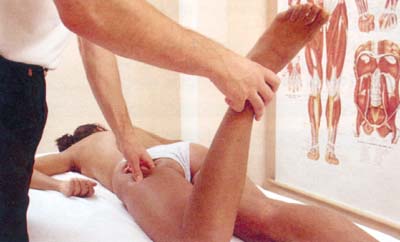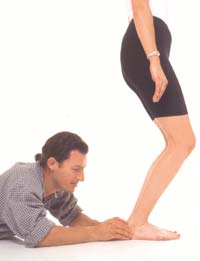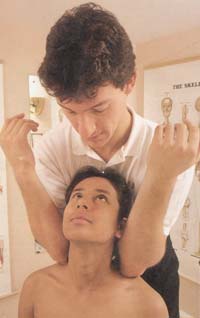Positive Health Online
Your Country

Hellerwork - Excellence with Ease
listed in bodywork, originally published in issue 68 - September 2001
The Big Picture
Hellerwork is a Structural Integration school founded in 1978. Overall there are about 250 active and certified practitioners worldwide using the Hellerwork service mark. Whilst noting various differences in emphasis from the other schools in the field, notably the Rolf Institute and the Guild for Structural Integration, the author asserts that the similarities are at least as important, and this article is offered to further general understanding of this relatively little known but uniquely powerful approach to human health and well-being.
Working on deep 'rotator' muscles to improve the leg's alignment and release tension in the hip joint
Provenance of Hellerwork
"Get out of your head and come to your senses."
Fritz Perls

Working on deep 'rotator' muscles to improve the leg's alignment and release tension in the hip joint
Hellerwork began in 1978 when Joseph Heller taught his first class at Dr Brugh Joy's Sky High Ranch in the California desert. Joseph Heller had agonized about leaving his position as the first president of the Rolf Institute. The redoubtable Dr Rolf was a great pioneer and had invented the Structural Integration protocol, which everyone came to know as Rolfing. Dr Rolf herself had started teaching lay practitioners at Esalen in 1965 at the behest of Fritz Perls, after many years working with chiropractors and osteopaths in the United States and, for a time in the late 1950s, in Tunbridge Wells, Kent.
Heller was the first Senior Rolfer to leave the fold, but he was not to be the last, and today, just 20 years after this first schism, the heirs of Rolfing are recognizing their common interests and opening advanced training classes to each other. This seems appropriate, because one of the strengths of Hellerwork is that whilst strongly rooted in an exceptionally powerful, focused approach to health through optimizing structure, the integrative impulse has been widened to include mind/body integration and balance on a number of levels.
This integrative impulse cannot be emphasized enough as a keynote of Hellerwork. Whilst Dr Rolf, and other great pioneers such as FM Alexander, Moshe Feldenkrais, Joseph Pilates and Milton Trager were strongly individualistic, highly opinionated, forceful characters (they had to be, they were carving out new territories in the rigid orthodoxy of their times, the first half of the 20th century), Joseph Heller has been more concerned with bringing things together. Hellerwork itself is a synthesis of the three streams of bodywork, movement education and the conversation that relates mind and body. From the outset, Joseph Heller has acknowledged his sources and his teachers: pre-eminently Dr Rolf, of whom he speaks fondly and with great respect, but also Judith Aston, who originally developed Rolf Movement and has gone on to create her own work too – Aston Patterning in all its manifestations – and Dr Brugh Joy, the former cardiac surgeon turned metaphysical teacher, and author of Joy's Way.[1]
Context of Hellerwork
Synergy
"The behaviour of whole systems unpredicted by the behaviour of the sum of the parts."
Buckminster Fuller
Here's one of Joseph Heller's co-collaborators in the founding of Hellerwork, Don St John, putting Hellerwork into a context:
"There is a growing momentum toward a holistic health perspective. Values of the holistic framework emphasize prevention, client participation, life-style choices involving nutrition, exercise, and relaxation, and a multi-discipline approach to health maintenance. The old model of 'treat the symptom, ignore the person' is fading with the emergence of the viewpoint that recognizes the wholeness of the individual.
"Within this holistic model is a field known as Somatic Education. Somatic Education addresses the whole person in relationship to movement, physical and psychological awareness, learning, and their environment. The focus is on the body 'as experienced from within the body'. Hellerwork is a Somatic Education discipline that is making an enormous contribution to this emerging model of health and well-being.
"In Hellerwork the entire musculo-skeletal structure of the body is considered and related to the individual's sense of well-being. Structure is viewed as relationship: relationship of the whole to the gravitational field in which it exists; relationship among parts within the whole; and relationship of structure to function. Isolated changes or symptom alleviation are not the concern of Hellerwork. Changes are perceived in relation to the whole body and whole person, and are aimed at improving the total energetic economy of the individual. Holistic theory states that how we live is central to the health we experience – that is, how and what we eat, exercise, relax, breathe, love, and think. Perhaps most important is how we negotiate those personal psychological issues that weave through the tapestry of our lives. Even at the very best, there are periodic rough spots, occasional frustration, and stress. At the other end of the continuum, there is intense frustration, chronic conflict, and debilitating disease.
"From the beginning of our lives, we are engaged with issues that set the foundation for our psycho-physical well-being. For example, we begin to develop a deep sense of basic trust in life as we successfully handle the terrain of infancy. If the conditions of our infancy are such that we do not develop that sense of trust, the psychophysical effects can cast dark and negative shadows over many ensuing years. There are issues to be mastered in every stage of life, and typically new stages resurrect old unresolved issues. These issues center around such themes as autonomy, competence, lovability, identity, intimacy, creativity, and spirituality. Our successes or failures in these are most critical to our psychophysical well-being.
"From the very beginning of our lives, we accumulate tension. Chronic tension is far more prevalent, extensive, and pervasive than most people imagine. Acute tension, is readily felt—such as stiffness in the neck or back. Chronic tension, however is typically outside of conscious awareness. Large areas of the body are simply unavailable to kinesthetic awareness.
"The strains of life's frustrations, the wear and tear of navigating our personal ships in rapidly changing sociological waters, the cumulative effect of poor health habits and physical accidents, are all embodied. All can be seen by the trained eye, felt by the experienced hand. All affect the structural integrity of our bodies. All affect the responsiveness and aliveness of our human tissues. All affect the quality of our participation in life.
Relieving wear and tear, improving the structural integrity of the human body, and educating the client in developing awareness are central objectives of Hellerwork. The value of improving structural integrity is inestimable and powerfully lessens the effects of aging.
"Hellerwork is a multi-level educational experience. Much is communicated in the quality of touch. Learning to let go, to accept pressure, to surrender in the sense of yielding and flowing, to create higher levels of aliveness, to learn to 'feel' one's body from the inside, are among the lessons taught in Hellerwork. Physical awareness improves as clients learn to use their bodies in ways that minimize effort and tension. This heightened awareness is paralleled psychologically as clients explore how their thoughts, attitudes, and feelings have an impact in and through their body.
"Hellerwork works with and educates a whole person. While not interested in symptom relief, it perhaps offers one of the best adjunctive approaches to chronic muscular pain syndromes. It emphasizes prevention and educates clients in self care. It teaches the powerful relationship of the body and the mind. With its potent range of application, Hellerwork is assuming a prominent place in our current holistic health paradigm."[2]
Don St John is a mind-body therapist with over 25 years' experience. He has a Master's Degree in Clinical Psychology with training in Gestalt, Reichian and Hakomi therapies. Don assisted Joseph Heller in founding the Hellerwork School and was its first director of administration. He is also trained in Hanna Somatic Education. Don produces and teaches Hellerwork training in the Pacific Northwest and is a senior trainer in the international school of Hellerwork. In recent years his work has been most influenced by Peter Levine, Emily Conrad, and Susan Harper. He currently leads workshops internationally.

Standing footwork to lengthen Achilles tendon.

Bringing the trapezius, one of the main back/shoulder muscles, back into its normal position
Practice of Hellerwork
"When the whole body and the whole being are included in the educational process,
the rate and depth at which learning can occur is truly staggering."
Joseph Heller
The practice of Hellerwork proceeds from the whole to the particular. By considering the relationship of the whole structure of the human form to the greater field in which we all exist – gravity – we are beginning at the beginning. It is within that context that individual 'problems' exist. So what we are saying is, "Let's get the overall system straightened out and then see what the problem is." The interesting thing is that lots of problems clear up in the process, and what isn't clearing up is usually a signpost to more intricate imbalances, or issues with occupational or habitual or psycho-emotional components, which can then be addressed in more detail. By following the protocol we are ensuring that no stone is left unturned, and the work, in general, proceeds from the ground up and from the outside in, in a gradual unwrapping of the fascial layers like unpeeling an onion one layer at a time. 'Problems' become 'opportunities' as they are re-contextualized as points of awareness in a growingly self-aware structure. In this, Hellerwork pays much more than lip-service to the much-abused concept of holism, delivering the experience to the client of being all-joined-up, and no longer a collection of symptoms and parts. Surely this is the true meaning of holos; healing as making whole.
The last thing that Joseph Heller wants is for the work which bears his name to ossify – to become bone-like – because Hellerwork is about fluidity, not rigidity, and the epitome of fluidity is water, which takes its form from whatever vessel contains it. In the teaching of Hellerwork a great deal of store is taken with a new view of anatomy, which recognizes the importance of the soft tissues and, crucially, the fascias or wrappings that envelop every structure in the body. Every nerve, muscle fibre, muscle, bone and organ is individually wrapped in its own bag of fascia. Dr Rolf's assertion of fascia as the organ of support confounded the Victorian conception of the body as a compressional structure where the bony skeleton was pre-eminent. The new anatomical understanding sees the body as a fluid, hydraulic and tensionally structured integrity, where stress is distributed quite evenly, and which is lightweight and economical in its use of energy, under optimum conditions!
The Core of Hellerwork
"Healing the Planet, one body at a time."
Donna Bajelis
Hellerwork is delivered in an exceptionally coherent and systematic series of 11 sessions, each combining three elements: the myo-fascial manipulation of the soft tissues, which creates space and freedom for the structure to realign and rebalance itself; the movement and awareness training to support and deepen and exercise that choice as it becomes available; and the conversation between practitioner and client designed to relate mind and body in all its myriad interconnectiveness. All three elements are capable of modulation and evolve as the practitioner gathers information and feedback from the client. Thus within the form there is a great deal of potential complexity, and each session, each client and each practitioner has its own dynamically evolving characteristic. This form is nevertheless capable of containing this complexity and keeping the sessions focused on the empowerment of the client.
One of the key distinctions of Hellerwork is that between the core and superficial musculature. The superficial muscles are voluntary, easily palpable and associated in general with the doing of life. Examples are trapezius, quadriceps and triceps. Core muscles are deep muscles associated with the spine and pelvis, less easily felt and more to do with being. Examples are adductors, ilio-psoas and scalenes. These muscles provide the core stability now being talked about in the more conscious exercise approaches like Pilates and the Putkisto. When 'posture' is imposed by superficial muscles onto shortened core musculature, conflict arises. That's what I mean when I say if you are trying to have good posture you have already missed the point.
Hellerwork provides a method of lengthening core musculature par excellence, allowing the effortless improvement in posture that is so inspiring and that allows clients to progress beyond the amelioration of symptoms to a place of positive well-being. 'Being deeply touched' has another meaning in the realm of emotion, which underlines the connection to the being rather than just the doing. The importance of approaching and balancing the core musculature including the diaphragm cannot be overemphasized. The material of the 1st, 3rd and 5th sessions of Hellerwork can all be directly related to free the mechanism of breathing.
The health and resilience of Hellerwork teaching is being maintained, even after the retirement of Joseph Heller from the active teaching of new students, because Joseph Heller has always taught that each of us brings something invaluable to the work – ourselves. Each practitioner develops their own tools and their own approach to the work that we do. Joseph Heller is very clear that technique is employed to produce results, and that it is the results that he is committed to, not the techniques. Again, the strength of the framework of Hellerwork allows the work to continue to evolve dynamically, without falling into either orthodoxy or eclecticism. For instance, numerous current Hellerwork practitioners have additional qualifications or experience with Cranio-Sacral Therapy, Hal Stone's Voice Dialogue, Hakomi, Continuum, Gabrielle Roth, Trager, Thomas Hanna's Somatics, Visceral Manipulation, Rubenfeld Synergy and Hubert Goddard's work, to mention some of the more interesting. Many Hellerwork practitioners are or have become chiropractors, physiotherapists, nurses, massage therapists, Pilates instructors, yoga teachers and psychotherapists. One leading practitioner and teacher of Hellerwork has completed additional qualifications in Alexander Technique and Feldenkrais Method.
All these influences are brought back to the Hellerwork context in conferences and experience workshops where sharing and cross-fertilization can take place.
Philosophy of Hellerwork
"You and I possess within ourselves
At all times
Under all circumstances
The power to transform the quality of our lives."
Werner Erhard
Hellerwork is as much educational as it is therapeutic. With its focus on empowering clients, it is teaching a profound level of self-responsibility, where the expert is the person themself.

Joseph Heller
Hellerwork is concerned with balance on all levels: initially left/right, top/bottom, inside and out; on a finer level the balance between reason and passion, between masculine and feminine, between strength and flexibility, in relationship to others; ultimately between person and planet.
We are creatures of habit, and old patterns are hard to change, because as soon as the world with all its stresses impinges upon this new-found equilibrium, there is a tendency for the mind to go into old, familiar ways of coping, unless there has been an expansion in the client's repertoire of stress management. Sometimes it's as easy (or as difficult) as learning to say 'no', and carve out some personal space. At other times we have to go through a process of gradually catching ourselves and interrupting some very deep-seated patterns like not breathing, and the vicious circle that that engenders (not breathing leading to tension, and tension preventing breathing, etc.).
In the area of posture, for instance, by releasing the chronic tension that we all tend to accumulate over time, choices are restored to the client that have been lost, and there is a very pleasant feeling of being straighter and taller, lighter and more at ease. At the same time, this beneficial state of affairs will not be maintained without the client choosing to exercise choice in the art of sitting, standing and walking.
Recognizing and having the experience of how the mind affects the body is very empowering in itself, because the body represents the unconscious and is the repository of all that has not been dealt with by the conscious mind. Joseph Heller has integrated the examination of matters more commonly thought of as psychological into the structural integration protocol using a simple naming of each session out of his experience of common themes that tended to recur during treatments. These themes of the sessions can be a starting point for an exploration of the rich connectivity between mind and body. Now, 20 years later, it is growingly obvious that we are 'bodyminds', and that many processes thought to reside exclusively in the brain are in fact happening in the body in general and the viscera in particular (the work of Candace Pert[3] and the discovery of neuro-peptides being particularly relevant).
Each session of Hellerwork can be related to a general human issue such as creativity, gender, control and surrender, and time of our life – childhood and adolescent issues are revisited, as well as issues relating to maturity. All of Hellerwork is working towards bringing consciousness into the body, to bring choice to, to empower and to bring awareness. There is a fundamental value embedded here about revealing the wisdom of the body. This is not about imposing anything from the outside, but rather of unconcealing the integrity of the design. Hellerwork is not about improving the design, it is about manifesting it more fully in each individual.
The Future of Hellerwork
"In the future I see Hellerwork at the forefront of a new discipline of Psychophysical Integration helping us to reintroduce the body's wisdom back into our culture. This new discipline will have far reaching consequences in the fields of fitness and performance. It will change our concept of ageing and what to expect from our bodies and our lives as we grow older. It will impact our views of education and the design of training procedures. It will influence ergonomic design and the quality of our work environment. Most importantly it will make us aware of our personal ecology and lead us to deal most effectively with our planet's ecology."
Joseph Heller
Reference
1. Brugh Joy. Joy's Way: A Map for the Transformational Journey. JP Tarcher. 1979.
2. St John Don. Journal of Holistic Health and Medicine 2 (3):28. Spring 1984.
3. Pert Candace. Molecules of Emotion: Why You Feel the Way You Feel. Pocket Books. 1999.
Books
Fuller R Buckminster. Critical Path. St Martin's Press. 1981.
Golten Roger. The Owner's Guide to the Body. Thorsons. 1999.
Heller Joseph and Henkin William. Bodywise. Wingbow Press. 1987.
Rolf Ida. Rolfing: The Integration of Human Structures. Harper & Row. 1977.
Further Information
UK Availability of Hellerwork
Two practitioners are now established in Devon – in Exeter and in Plymouth, one in the Cotswolds/Birmingham area, one in Scotland, one in Ireland and the rest of the UK practitioners are in the London and Herts area. Two other Hellerwork practitioners are to be found in Europe, in Switzerland and Germany.
Internet Resources
www.hellerwork.com
www.rolf.org
www.bfi.org
www.brughjoy.com
www.astonpatterning.com
www.positivehealth.com/permit/Articles/Regular/rudolf12.htm (Alan Rudolf's article remembering Dr Rolf)
www.structuralmedicine.com
Comments:
-
No Article Comments available